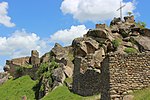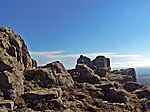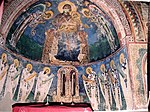List of World Heritage Sites in North Macedonia
The
As of 2021[update], there are two sites in North Macedonia inscribed on the list and further four on the tentative list. Natural and Cultural Heritage of the Ohrid region was inscribed at the 3rd UNESCO session in 1979. In 2019, the site was expanded to include the Albanian portion of the lake, thus becoming a transnational site.[3] In 2021, the Ancient and Primeval Beech Forests of the Carpathians and Other Regions of Europe site was extended to include a beech forest within Mavrovo National Park, the site is shared with 17 European countries. The tentative sites are the Cave Slatinski Izvor, the geological formation Markovi Kuli, the megalithic archaeo-astronomical complex Kokino, and the Church of St George in Kurbinovo.[4]
World Heritage Sites
UNESCO lists sites under ten criteria; each entry must meet at least one of the criteria. Criteria i through vi are cultural, and vii through x are natural.[5]
| Site | Image | Location ( municipality )
|
Year listed | UNESCO data | Description |
|---|---|---|---|---|---|
| Natural and Cultural Heritage of the Ohrid region* | 
|
Ohrid | 1979 | i, iii, iv, vii (mixed) | The town of Ohrid is one of the oldest human settlements in Europe with archaeological remains from the Bronze Age to the Medieval Era. It is a prominent testimony of Slavonic monastery and the first Slavonic University in the Balkans. Lake Ohrid dates to the pre-glacial era and provides a unique refuge for numerous endemic and relict freshwater species of flora and fauna. The site was extended in 1980 and a minor modification of the boundaries took place in 2009. In 2019, the site was extended to include the Albanian portion of the lake.[3]
|
| Ancient and Primeval Beech Forests of the Carpathians and Other Regions of Europe* | 
|
Mavrovo and Rostuša
|
2021 | 1133quater; ix (natural) | This site comprises forests in 18 European countries. These forests demonstrate the postglacial expansion process of European beech forests and exhibit the most complete and comprehensive ecological patterns and processes of pure and mixed stands of European beech across a variety of environmental conditions. The site was first listed in 2007 in Slovakia and Ukraine. It was extended in 2011, 2017, and 2021 to include forests in several other countries. The Dlaboka River valley in North Macedonia was added to the list in 2021.[6]
|
Tentative list
In addition to the sites inscribed on the World Heritage list, member states can maintain a list of tentative sites that they may consider for nomination. Nominations for the World Heritage list are only accepted if the site was previously listed on the tentative list.[7] As of 2021, North Macedonia recorded four sites on its tentative list.[4]
| Site | Image | Location ( municipality )
|
Year listed | UNESCO criteria | Description |
|---|---|---|---|---|---|
| Cave Slatinski Izvor | 
|
Makedonski Brod | 2004 | vii, viii, ix (natural) | The longest explored cave system in North Macedonia. The caves are located above the Slatina river near the village of Slatina, North Macedonia and were probably created during the last ice age. Several cave formations are found in the system.[8] |
| Markovi Kuli | 
|
Prilep | 2004 | vii, viii, ix (natural) | A geological formation consisting of magmatic and metamorphic rocks. The configuration of the terrain itself and the favorable geographical position caused this area to be constantly populated at least since the Bronze Age.[9] |
| Archaeo-astronomical Site Kokino | 
|
Staro Nagoričane | 2009 | i, ii, iii (cultural) | A megalithic astronomical complex on the top of the mountain Tatićev Kamen, dating to the Bronze Age. Stone marker cuttings indicate the spots of the rising of the Sun in the days of the summer solstice, the winter solstice, the spring and autumn equinox, as well as the rising of the full Moon on the eastern horizon, when it has a maximum and minimum declination in winter and summer. The site was uncovered in 2001.[10]
|
| Church St. George (Sv Gjorgji) Kurbinovo | 
|
Resen | 2020 | i, ii, iii (cultural) | A 12th-century Orthodox monastery in the Prespa region, notable for its rare frescoes from the Macedonian Renaissance period of Byzantine art. St George is the largest aisleless church in the country.[11] |
References
- ^ "UNESCO World Heritage Centre The World Heritage Convention". UNESCO World Heritage Centre. 25 December 2017. Archived from the original on 23 May 2016. Retrieved 27 December 2017.
- ^ "the former Yugoslav Republic of Macedonia". UNESCO World Heritage Centre. 25 December 2017. Archived from the original on 13 May 2012. Retrieved 7 May 2011.
- ^ a b "Natural and Cultural Heritage of the Ohrid region". UNESCO World Heritage Centre. Archived from the original on 17 December 2017. Retrieved 24 August 2018.
- ^ a b "UNESCO World Heritage Centre Tentative Lists: Macedonia". UNESCO World Heritage Centre. Archived from the original on 6 August 2012. Retrieved 6 July 2019.
- ^ "UNESCO World Heritage Centre The Criteria for Selection". UNESCO World Heritage Centre. Archived from the original on 12 June 2016. Retrieved 17 August 2018.
- ^ "Ancient and Primeval Beech Forests of the Carpathians and Other Regions of Europe". UNESCO World Heritage Centre. Archived from the original on 17 October 2020. Retrieved 29 July 2021.
- ^ "UNESCO World Heritage Centre Tentative Lists". UNESCO World Heritage Centre. Archived from the original on 20 July 2017. Retrieved 25 July 2017.
- ^ "Cave Slatinski Izvor". UNESCO World Heritage Centre. Archived from the original on 24 August 2018. Retrieved 24 August 2018.
- ^ "Markovi Kuli". UNESCO World Heritage Centre. Archived from the original on 25 August 2018. Retrieved 24 August 2018.
- ^ "Archaeo-astronomical Site Kokino". UNESCO World Heritage Centre. Archived from the original on 2 November 2012. Retrieved 24 August 2018.
- ^ "Church St. George (Sv Gjorgji) Kurbinovo". UNESCO World Heritage Centre. Archived from the original on 16 April 2021. Retrieved 16 April 2020.




